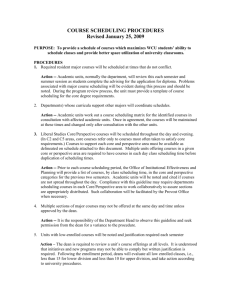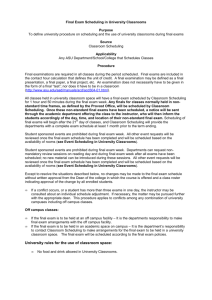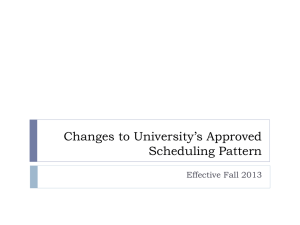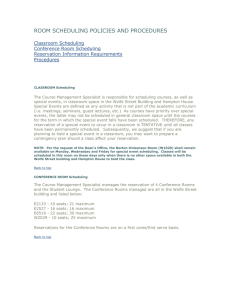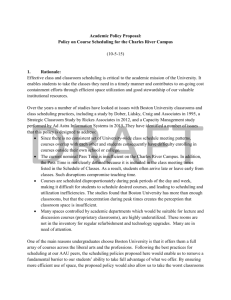Class Times
advertisement
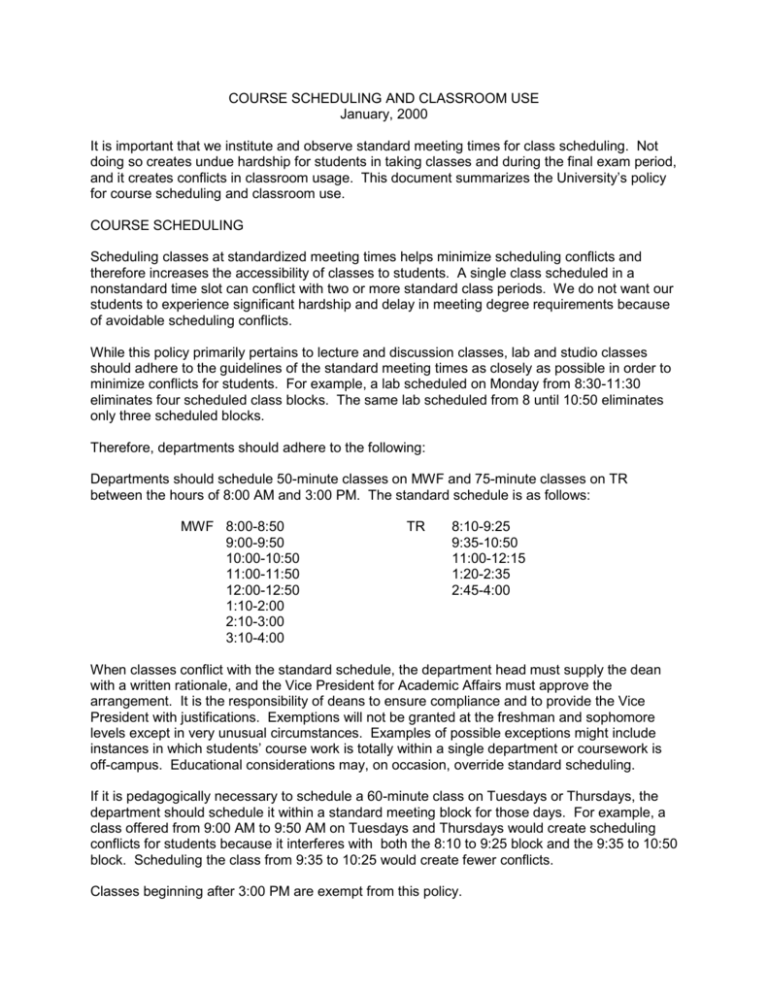
COURSE SCHEDULING AND CLASSROOM USE January, 2000 It is important that we institute and observe standard meeting times for class scheduling. Not doing so creates undue hardship for students in taking classes and during the final exam period, and it creates conflicts in classroom usage. This document summarizes the University’s policy for course scheduling and classroom use. COURSE SCHEDULING Scheduling classes at standardized meeting times helps minimize scheduling conflicts and therefore increases the accessibility of classes to students. A single class scheduled in a nonstandard time slot can conflict with two or more standard class periods. We do not want our students to experience significant hardship and delay in meeting degree requirements because of avoidable scheduling conflicts. While this policy primarily pertains to lecture and discussion classes, lab and studio classes should adhere to the guidelines of the standard meeting times as closely as possible in order to minimize conflicts for students. For example, a lab scheduled on Monday from 8:30-11:30 eliminates four scheduled class blocks. The same lab scheduled from 8 until 10:50 eliminates only three scheduled blocks. Therefore, departments should adhere to the following: Departments should schedule 50-minute classes on MWF and 75-minute classes on TR between the hours of 8:00 AM and 3:00 PM. The standard schedule is as follows: MWF 8:00-8:50 9:00-9:50 10:00-10:50 11:00-11:50 12:00-12:50 1:10-2:00 2:10-3:00 3:10-4:00 TR 8:10-9:25 9:35-10:50 11:00-12:15 1:20-2:35 2:45-4:00 When classes conflict with the standard schedule, the department head must supply the dean with a written rationale, and the Vice President for Academic Affairs must approve the arrangement. It is the responsibility of deans to ensure compliance and to provide the Vice President with justifications. Exemptions will not be granted at the freshman and sophomore levels except in very unusual circumstances. Examples of possible exceptions might include instances in which students’ course work is totally within a single department or coursework is off-campus. Educational considerations may, on occasion, override standard scheduling. If it is pedagogically necessary to schedule a 60-minute class on Tuesdays or Thursdays, the department should schedule it within a standard meeting block for those days. For example, a class offered from 9:00 AM to 9:50 AM on Tuesdays and Thursdays would create scheduling conflicts for students because it interferes with both the 8:10 to 9:25 block and the 9:35 to 10:50 block. Scheduling the class from 9:35 to 10:25 would create fewer conflicts. Classes beginning after 3:00 PM are exempt from this policy. Group testing, often associated with high-enrollment courses, should occur only between 5:00 PM and 7:00 PM. Departments are discouraged from scheduling courses during this time block. To increase accessibility to nontraditional students, departments should try to schedule some classes outside of the 8:00 AM to 3:00PM window. As a general guideline, the percentage of classes beginning on or after 4:00 PM and prior to 8:00 AM should be increased to 10 percent, with a minimum of 5 percent scheduled for 7:00 PM or later or on weekends. These percentages should be based upon the total number of regularly scheduled lecture classes and should exclude laboratory sections, independent study classes, etc. Deans are responsible for establishing the above course distributions, subject to reasonable judgments based on the demand for classes outside the 8:00 AM to 3:00PM window. CLASSROOM USE Similar issues pertain to classroom use. Scheduling courses at non-standard times makes it difficult to use our classroom space efficiently. Holding small classes in large rooms can also interfere with the optimal use of space. Normally, departmental classroom assignments will carry over from fall to fall and spring to spring. That is, a department can expect to have the same classrooms available for scheduling at the same times as were used in the same semester the previous year. Departments should schedule their classes in the allocated rooms. If departments need more or different classrooms than those assigned from the previous year, they should contact the classroom coordinator. Permission to schedule classes outside the department’s allotment will be subject to availability of classrooms from the general pool. Unused classrooms will revert to the general pool. Classes in which enrollments are consistently and significantly below classroom capacity are subject to administrative reallocation. The Classroom Coordinator will monitor classroom use and enrollments. Any class that does not fill a room to 50% of capacity for two consecutive years will be considered for relocation. The Classroom Coordinator will notify the appropriate college dean in such cases. The dean should then consult with the affected department. When the dean and department head support the recommendation to relocate a classroom, the Classroom Coordinator will make the change. Special considerations, such as unusual space requirements, types of furnishings, or instructional technology support may justify continued use of a specific room by low-enrollment classes. These cases are subject to the concurrence of the dean and Classroom Coordinator. The Office of Institutional Analysis will continue to have the responsibility to monitor course scheduling and classroom utilization. Exceptions to these policies may be granted by the Vice President for Academic Affairs.


